CBSE 10th Standard Maths Subject Probability Case Study Questions With Solution 2021
By QB365 on 22 May, 2021
QB365 Provides the updated CASE Study Questions for Class 10 Maths, and also provide the detail solution for each and every case study questions . Case study questions are latest updated question pattern from NCERT, QB365 will helps to get more marks in Exams
QB365 - Question Bank Software
CBSE 10th Standard Maths Subject Probability Case Study Questions With Solution 2021
10th Standard CBSE
-
Reg.No. :
Maths
-
Two friends Richa and Sohan have some savings in their piggy bank. They decided to count the total coins they both had. After counting they find that they have fifty \(\begin{equation} ₹ \end{equation} \) 1 coins, forty eight \(\begin{equation} ₹ \end{equation} \) 2 coins, thirty six \(\begin{equation} ₹ \end{equation} \) 5 coins, twenty eight \(\begin{equation} ₹ \end{equation} \)10 coins and eight \(\begin{equation} ₹ \end{equation} \) 20 coins. Now, they said to Nisha, their another friends, to choose a coin randomly.
Find the probability that the coin chosen is
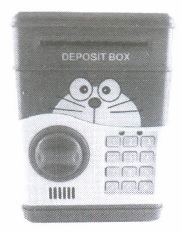
(i) \(\begin{equation} ₹ \end{equation} \)5 coin(a) \(\begin{equation} \frac{17}{55} \end{equation}\) (b) \(\begin{equation} \frac{36}{85} \end{equation}\) (c) \(\begin{equation} \frac{18}{85} \end{equation}\) (d) \(\begin{equation} \frac{1}{15} \end{equation}\) (ii) \(\begin{equation} ₹ \end{equation} \) 20 coin
(a) \(\begin{equation} \frac{13}{85} \end{equation}\) (b) \(\begin{equation} \frac{4}{85} \end{equation}\) (c) \(\begin{equation} \frac{3}{85} \end{equation}\) (d) \(\begin{equation} \frac{4}{15} \end{equation}\) (iii) not a \(\begin{equation} ₹ \end{equation} \) 10 coin
(a) \(\begin{equation} \frac{15}{31} \end{equation}\) (b) \(\begin{equation} \frac{36}{85} \end{equation}\) (c) \(\begin{equation} \frac{1}{5} \end{equation}\) (d) \(\begin{equation} \frac{71}{85} \end{equation}\) (iv) of denomination of atleast \(\begin{equation} ₹ \end{equation} \)10.
(a) \(\begin{equation} \frac{18}{85} \end{equation}\) (b) \(\begin{equation} \frac{36}{85} \end{equation}\) (c) \(\begin{equation} \frac{1}{17} \end{equation}\) (d) \(\begin{equation} \frac{16}{85} \end{equation}\) (v) of denomination of atmost \(\begin{equation} ₹ \end{equation} \) 5.
(a) \(\begin{equation} \frac{67}{85} \end{equation}\) (b) \(\begin{equation} \frac{36}{85} \end{equation}\) (c) \(\begin{equation} \frac{4}{85} \end{equation}\) (d) \(\begin{equation} \frac{18}{85} \end{equation}\) (a) -
In a play zone, Nishtha is playing claw crane game which consists of 58 teddy bears, 42 pokemons, 36 tigers and 64 monkeys. Nishtha picks a puppet at random. Now, find the probability of getting
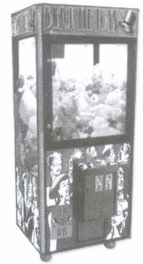
(i) a tiger(a) \(\begin{equation} \frac{3}{50} \end{equation}\) (b) \(\begin{equation} \frac{9}{50} \end{equation}\) (c) \(\begin{equation} \frac{1}{25} \end{equation}\) (d) \(\begin{equation} \frac{27}{50} \end{equation}\) (ii) a monkey
(a) \(\begin{equation} \frac{8}{25} \end{equation}\) (b) \(\begin{equation} \frac{4}{25} \end{equation}\) (c) \(\begin{equation} \frac{16}{25} \end{equation}\) (d) \(\begin{equation} \frac{1}{5} \end{equation}\) (iii) a teddy bear
(a) \(\begin{equation} \frac{41}{50} \end{equation}\) (b) \(\begin{equation} \frac{29}{50} \end{equation}\) (c) \(\begin{equation} \frac{29}{100} \end{equation}\) (d) \(\begin{equation} \frac{41}{100} \end{equation}\) (iv) not a monkey
(a) \(\begin{equation} \frac{1}{25} \end{equation}\) (b) \(\begin{equation} \frac{8}{25} \end{equation}\) (c) \(\begin{equation} \frac{13}{25} \end{equation}\) (d) \(\begin{equation} \frac{17}{25} \end{equation}\) (v) not a pokemon
(a) \(\begin{equation} \frac{27}{100} \end{equation}\) (b) \(\begin{equation} \frac{43}{100} \end{equation}\) (c) \(\begin{equation} \frac{61}{100} \end{equation}\) (d) \(\begin{equation} \frac{79}{100} \end{equation}\) (a) -
Rohit wants to distribute chocolates in his class on his birthday. The chocolates are of three types: Milk chocolate, White chocolate and Dark chocolate. If the total number of students in the class is 54 and everyone gets a chocolate, then answer the following questions.
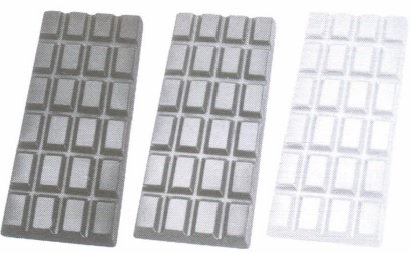
(i) If the probability of distributing milk chocolates is 1/3, then the number of milk chocolates Rohit has, is(a) 18 (b) 20 (c) 22 (d) 30 (ii) If the probability of distributing dark chocolates is 4/9, then the number of dark chocolates Rohit has, is
(a) 18 (b) 25 (c) 24 (d) 36 (iii) The probability of distributing white chocolates is
(a) \(\begin{equation} \frac{11}{27} \end{equation}\) (b)\(\begin{equation} \frac{8}{21} \end{equation}\) (c) \(\begin{equation} \frac{1}{9} \end{equation}\) (d) \(\begin{equation} \frac{2}{9} \end{equation}\)
(iv) The probability of distributing both milk and white chocolates is(a) \(\begin{equation} \frac{3}{17} \end{equation}\) (b) \(\begin{equation} \frac{5}{9} \end{equation}\) (c) \(\begin{equation} \frac{1}{3} \end{equation}\) (d) \(\begin{equation} \frac{1}{27} \end{equation}\) (v) The probability of distributing all the chocolates is
(a) 0 (b) 1 (c) \(\begin{equation} \frac{1}{2} \end{equation}\) (d) \(\begin{equation} \frac{3}{4} \end{equation}\) (a) -
Three persons toss 3 coins simultaneously and note the outcomes. Then, they ask few questions to one another. Help them in finding the answers of the following questions.
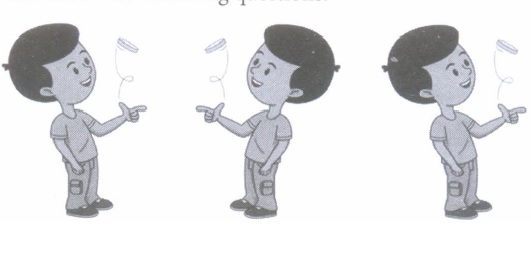
(i) The probability of getting atmost one tail is(a) 0 (b) 1 (c) \(\begin{equation} \frac{1}{2} \end{equation}\) (d) \(\begin{equation} \frac{1}{4} \end{equation}\) (ii) The probability of getting exactly 1 head is
(a) \(\begin{equation} \frac{1}{2} \end{equation}\) (b) \(\begin{equation} \frac{1}{4} \end{equation}\) (c) \(\begin{equation} \frac{1}{8} \end{equation}\) (d) \(\begin{equation} \frac{3}{8} \end{equation}\) (iii) The probability of getting exactly 3 tails is
(a) 0 (b) 1 (c) \(\begin{equation} \frac{1}{4} \end{equation}\) (d) \(\begin{equation} \frac{1}{8} \end{equation}\) (iv) The probability of getting atmost 3 heads is
(a) 0 (b) 1 (c) \(\begin{equation} \frac{1}{2} \end{equation}\) (d) \(\begin{equation} \frac{1}{8} \end{equation}\) (v) The probability of getting atleast two heads is
(a) 0 (b) 1 (c) \(\begin{equation} \frac{1}{2} \end{equation}\) (d) \(\begin{equation} \frac{1}{4} \end{equation}\) (a) -
Prateek goes to a toy shop to purchase a building block kit for his son. He found that the kit contains 120 blocks, of which 40 are red, 25 are blue, 30 are green and the rest are yellow. His son picks up a block at random. Find the probability that the block is
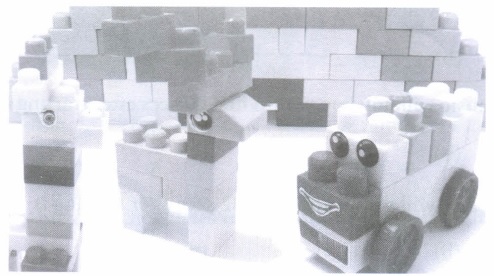
(i) of red colour(a) 0 (b) 1 (c) \(\begin{equation} \frac{1}{2} \end{equation}\) (d) \(\begin{equation} \frac{1}{3} \end{equation}\) (ii) not of yellow colour
(a) \(\begin{equation} \frac{1}{6} \end{equation}\) (b) \(\begin{equation} \frac{1}{4} \end{equation}\) (c) \(\begin{equation} \frac{19}{24} \end{equation}\) (d) \(\begin{equation} \frac{19}{25} \end{equation}\) (iii) of green colour
(a) \(\begin{equation} \frac{1}{8} \end{equation}\) (b) \(\begin{equation} \frac{1}{10} \end{equation}\) (c) \(\begin{equation} \frac{1}{4} \end{equation}\) (d) \(\begin{equation} \frac{1}{12} \end{equation}\) (iv) of yellow colour
(a) \(\begin{equation} \frac{15}{118} \end{equation}\) (b) \(\begin{equation} \frac{5}{24} \end{equation}\) (c) \(\begin{equation} \frac{17}{24} \end{equation}\) (d) \(\begin{equation} \frac{19}{50} \end{equation}\) (v) not of blue colour
(a) \(\begin{equation} \frac{1}{8} \end{equation}\) (b) \(\begin{equation} \frac{19}{24} \end{equation}\) (c) \(\begin{equation} \frac{19}{31} \end{equation}\) (d) \(\begin{equation} \frac{16}{55} \end{equation}\) (a)
Case Study Questions
*****************************************
CBSE 10th Standard Maths Subject Probability Case Study Questions With Solution 2021 Answer Keys
-
Total number of coins = 50 + 48 + 36 + 28 + 8 = 170
(i) (c): Number of \(\begin{equation} ₹ \end{equation} \) 5 coins = 36
Required probability = \(\begin{equation} \frac{36}{70}=\frac{18}{85} \end{equation}\)
(ii) (b): Number of \(\begin{equation} ₹ \end{equation} \)20 coins = 8
Required probability = \(\begin{equation} \frac{8}{170}=\frac{4}{85} \end{equation}\)
(iii) (d): Number of \(\begin{equation} ₹ \end{equation} \)10 coins = 28
Probability (coin is of \(\begin{equation} ₹ \end{equation} \)10) = \(\begin{equation} \frac{28}{170} \end{equation}\)
Required probability = 1 - P(coin is of 10)
\(\begin{equation} =1-\frac{28}{170}=\frac{142}{170}=\frac{71}{85} \end{equation}\)
(iv) (a) : Total number of coins of \(\begin{equation} ₹ \end{equation} \)10 and \(\begin{equation} ₹ \end{equation} \) 20
= 28 + 8 = 36
Required probability = \(\begin{equation} \frac{36}{170}=\frac{18}{85} \end{equation}\)
(v) (a): Total number of coins of \(\begin{equation} ₹ \end{equation} \)1, \(\begin{equation} ₹ \end{equation} \)2 and \(\begin{equation} ₹ \end{equation} \) 5
= 50 + 48 + 36 = 134
Required probability = \(\begin{equation} \frac{134}{170}=\frac{67}{85} \end{equation}\) -
Total number of puppets in claw crane = 58 + 42 + 36 + 64 = 200
(i) (b): P(picking a tiger) = \(\begin{equation} \frac{36}{200}=\frac{9}{50} \end{equation}\)
(ii) (a): P(picking a monkey) = \(\begin{equation} \frac{64}{200}=\frac{8}{25} \end{equation}\)
(iii) (c) : P(picking a teddy bear) = \(\begin{equation} \frac{58}{200}=\frac{29}{100} \end{equation}\)
(iv) (d) : P(not picking a monkey) = 1 - P(picking a monkey)
\(\begin{equation} =1-\frac{8}{25}=\frac{17}{25} \end{equation}\)
(v) (d): P(picking a pokemon) = \(\begin{equation} \frac{42}{200}=\frac{21}{100} \end{equation}\)
P(not picking a pokemon) = 1 - P(picking a pokemon)
\(\begin{equation} =1-\frac{21}{100}=\frac{79}{100} \end{equation}\) -
Since, every student get one chocolate. So, number of chocolates Rohit has is equal to the number of students in the class.
(i) (a): Let number of milk chocolates Rohit has = x
Probability of distributing milk chocolates = \(\begin{equation} \frac{1}{3} \end{equation}\)
\(\begin{equation} \Rightarrow \frac{x}{54}=\frac{1}{3} \Rightarrow x=\frac{54}{3}=18 \end{equation}\)
(ii) (c): Let number of dark chocolates Rohit has = y
Probability of distributing dark chocolates = \(\begin{equation} \frac{4}{9} \end{equation}\)
\(\begin{equation} \Rightarrow \frac{y}{54}=\frac{4}{9} \Rightarrow y=\frac{4 \times 54}{9}=24 \end{equation}\)
(iii) (d) : Number of white chocolates Rohit has = 54 -(18 + 24) = 12
Required probability = \(\begin{equation} \frac{12}{54}=\frac{2}{9} \end{equation}\)
(iv) (b) : Total number of milk and white chocolates = 18 + 12 = 30
Required probability = \(\begin{equation} \frac{30}{54}=\frac{5}{9} \end{equation}\)
(v) (b): Since all students gets one chocolate. So, total number of chocolates distributed = 54
\(\begin{equation} \text { Required probability }=\frac{54}{54}=1 \end{equation}\) -
Sample space (5) = {HHH, HHT, HTH, HTT, THH, THT, TTH, TTT}
\(\Rightarrow\)n(5) = 8
(i) (c): Let A be the event of getting atmost one tail.
A = {HHH, HHT, HTH, THH}
\(\Rightarrow\)n(A) = 4
Required probability = \(\begin{equation} \frac{4}{8}=\frac{1}{2} \end{equation}\)
(ii) (d): Let B be the event of getting exactly 1 head. B = {HTT, THT, TTH}
\(\Rightarrow\) n(B) = 3
Required probability = \(\begin{equation} \frac{3}{8} \end{equation}\)
(iii) (d) : Let C be the event of getting exactly 3 tails.
C = {TTT} \(\Rightarrow\) n( C) = 1
Required probability = \(\begin{equation} \frac{1}{8} \end{equation}\)\(\begin{equation} \frac{1}{8} \end{equation}\)\(\begin{equation} \frac{1}{8} \end{equation}\)\(\begin{equation} \frac{1}{8} \end{equation}\)
(iv) (b) : Let D be the event of getting atmost 3 heads.
D = {HHH, HHT, HTH, HTT, THH, THT, TTH, TTT}
\(\Rightarrow\)n(D) = 8
Required probability = \(\begin{equation} \frac{8}{8}=1 \end{equation}\)
(v) (c): Let E be the event of getting atleast two heads.
E = {HHT, HTH, THH, HHH}
\(\Rightarrow\)n(E) = 4
Required probability = \(\begin{equation} \frac{n(E)}{n(S)}=\frac{4}{8}=\frac{1}{2} \end{equation}\) -
Total number of blocks in the kit = 120
Number of red blocks = 40
Number of blue blocks = 25
Number of green blocks = 30
Number of yellow blocks = 120 - (40 + 25 + 30)
= 120 - 95 = 25
(i) (d): P(block is red) \(\begin{equation} =\frac{40}{120}=\frac{1}{3} \end{equation}\)
(ii) (c): P(block is not yellow) = 1 - P(block is yellow)
\(\begin{equation} =1-\frac{25}{120}=1-\frac{5}{24}=\frac{19}{24} \end{equation}\)
(iii) (c) : P(block is green) = \(\begin{equation} \frac{30}{120}=\frac{1}{4} \end{equation}\)
(iv) (b) : P(block is yellow) = \(\begin{equation} \frac{5}{24} \end{equation}\)
(v) (b): P(block is not blue) = 1 - P(block is blue)
\(\begin{equation} =1-\frac{25}{120}=1-\frac{5}{24}=\frac{19}{24} \end{equation}\)
Case Study Questions

























